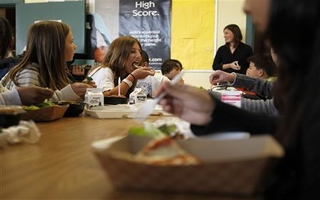 Strict school lunch standards that are similar to new regulations from the U.S. government may be tied to healthier body weights among students, according to a new study.
Strict school lunch standards that are similar to new regulations from the U.S. government may be tied to healthier body weights among students, according to a new study."I think it's evidence that healthier school lunches have a positive effect but it's preliminary evidence. It's far from definitive," said Anne Barnhill, who studies food policy at University of Pennsylvania in Philadelphia but was not involved with the new research.
The new findings, published in JAMA Pediatrics on Monday, bode well for the standards introduced by the U.S. Department of Agriculture (USDA) in January 2012 that - among other moves - set maximums for calories offered during lunch and mandate that only skim or reduced-fat milk are offered to students.
Prior to 2012, the USDA only set minimum calorie counts for school lunches. Now, the agency requires school lunches to fall between 550 calories and 850 calories - depending on a child's grade level.
Previous studies questioned whether the USDA's National School Lunch Program, which provides free or reduced-priced meals to low-income students, helped children maintain a healthy weight. Research also found the lunches sometimes didn't meet standards and students who ate those meals tended to be obese.
Dr. Daniel Taber, the new study's lead author from the Institute for Health Research and Policy at the University of Illinois at Chicago, said students who receive free or reduced-price lunches from the government tend to be more obese, but that may be due to their families' low-income status.
And while it's still too early to know the true effects of the new USDA regulations - other public policies could also play a role - the researchers said some states had already implemented their own lunch requirements that exceeded the federal standards by 2012.
Staying away from vending machines
For the new study, they compared the gap in obesity prevalence between students in states with strict lunch standards in 2006 and 2007 - before the new regulations took place - to states with less restrictive regulations.
Fewer than ten states exceeded the USDA's standards back then. The states could do that in a variety of ways. For example, they could have increased the amount of fruits and vegetables available to students or mandated schools only offer skim or low-fat milk.
Overall, the researchers found students who received free or reduced-price lunches were more obese than students who did not take part in the USDA program, but the gap in obesity prevalence was much smaller in states with strict lunch standards.
In states that did not exceed the standards, 26 percent of students in the lunch program were considered obese, compared to about 14 percent of students who did not get free or reduced-price lunches.
That compared to about 21 percent of students in the lunch program and about 17 percent of students who weren't in the program in states that exceeded the standards.
What's more, the researchers also found that students in states with strict lunch standards did not seem to compensate with less-healthy food from vending machines or other places.
"We didn't find any evidence of that, and we found healthier school meals have the potential to reduce obesity," Taber said.
Nutritionist Marion Nestle of New York University, who wrote an editorial accompanying the new study, told Reuters Health in an email that the study shows that regulations work.
"This is important work and should stimulate government agencies to take a closer look at what they might do to make the food environment a lot healthier for children and adults," Nestle said.





